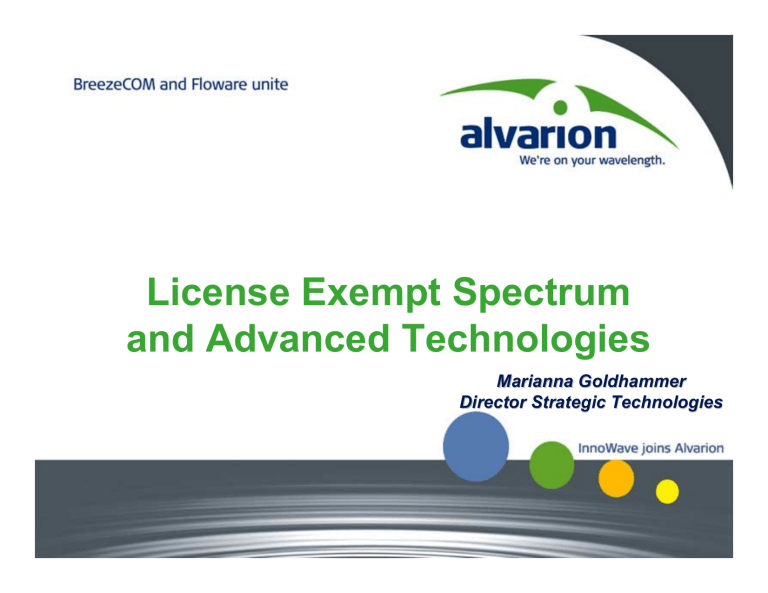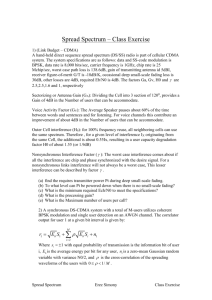License Exempt Spectrum and Advanced Technologies Marianna Goldhammer Director Strategic Technologies

License Exempt Spectrum and Advanced Technologies
Contents
• BWA Market trends
• Power & Spectral Ingredients for Successful BWA
Deployments
• Are regulations a limit for new radio technologies? Do they enable “spectrum mess” ?
• LE vision - new regulatory rules
• Conclusions
Definition of Broadband Depends on Geography
Time needed to download
3 MB file
Fast ADSL
TOKYO
Cable
KANSAS CITY
ADSL
BUCHAREST
Dial-up
GABERONE
0
1.5 Mb/s
0.512 Mb/s
0.056 Mb/s
5 10 15 20 25
26 Mb/s 1 sec.
30
17 sec.
52 sec.
457 sec.
Megabits per second
Source: Pyramid Research
Broadband Revolution
BWA Follows DSL Trend
(000’s)
450,000
400,000
350,000
300,000
250,000
200,000
150,000
100,000
50,000
0
2003
Source: Yankee Group
Global Subscribers
2004 2005 2006 2007
DSL Cable Wireless
2008
License Exempt Broadband by Country Type
Service Provider Types
!
ILECs
!
CLECs
!
Large (Nationwide) ISPs
!
Urban
!
Sub Urban
Region
Types of Service
!
Business Data & Voice
!
Residential Data
Service Provider Types
!
Large ISPs
!
small WISPs
!
ILECs (limited deployment)
Region
!
Sub Urban
!
Rural
Types of Service
!
Residential Data
!
Business Data
Power & Spectral Ingredients for
Successful BWA Deployments
High Power for Positive Business Case
• Efficient and high quality BWA requires higher power transmissions than WLAN:
• Larger cell size
• Outdoor-to-indoor penetration ( NEW!
)
• Higher sustained aggregated throughput
• Increased overall cell performance
High Power, Advanced Technologies for Positive
Business Case - Example
• Covered area: 225 Mile^2
• Penetration Rate – 18% @ 5Yr
•
Year 1
0.80%
• Household Density:
Year 2
1.80%
Year 3
4.80%
Year 4
6.60%
• Sub urban high density - 4500 HH/mi^2
• Sub urban low density- 1500 HH/mi^2
• Rural -500 HH/mi^2
Year 5
4.00%
BreezeMAX using 5.8GHz, FCC ISM rules, TDD, 5MHz channels
Area Configuration No. Of
BST’s
BST Range
[Km]
Total SU per BS
Price Per
Line
ROI
Rural High
Suburban Low
Suburban High
Macro
4 ways, 6 sectors
Macro
2 ways, 3 sectors
Macro
4 ways, 6 sectors
Macro
4 ways, 4 sectors
Months
Months
Months
Months
High Power for Positive Business Case (contd.)
• Operator Benefits:
• More subscribers in each cell reduce the base station CAPEX and OPEX load on each subscriber.
• Increased subscriber throughput (higher modulation states can be used) allows for higher subscription rates for lucrative services.
• Faster ROI, Higher NPV
• Subscriber Benefits:
• Affordable subscription rates.
• High throughput
Present and near future
License Exempt Spectrum Allocations
• Lack of spectrum
• 2.4GHz
• Interference in 2.4GHz ISM band is driving service providers and equipment vendors away from this band.
• Europe: limited power, almost no use for access
• 5GHz
• US: U-NII and upper ISM bands (5.15 – 5.85 GHz)
• FWA applications using mainly roof-top antennae High cost / line
• No 5.8GHz European allocation yet; CEPT studies consider less power than allowed by FCC
• Needed allocation of LE spectrum below 3GHz!
• Better coping with high distances and NLOS conditions
Standards and the “mess” in LE bands
• IEEE 802.11
• Define “listen before send”
• Does not work with FWA (stations are “hidden”, due to directional antennae)
• Does not work in NLOS:
• most of the stations are “hidden” due to “shadowing” and wall isolation effects
• IEEE 802.15
• Frequency hopping!
• IEEE 802.16
• Does not resolve the adjacent channel interference
• IEEE 802.11a, 802.16
• Dynamic channel selection
• With 20MHz channels, may work only in 5GHz!
BWA and interference mitigation with higher power allowance
• Statistical approach
• Reduce interference levels
• Beam forming / switching – new FCC proposal
• Limited time occupancy – new FCC proposal
• Frequency Hopping
• Not suitable for broadband (channel no. limitation)
• Not suitable for QoS
• Pros: fast solution to allow higher e.I.r.p. levels
• Contras: no QoS guarantee
• BW Reservation approach
• Technology independent
• Inter-system communication – why not?
• Pros: suitable to new traffic types, requiring QoS
• Not defined yet !
BWA: down-link cell-size limitation paradox
• 802.16a / ETSI HiperMAN / WiMAX define up-link OFDMA
• The Subscriber Terminal (ST) power may be concentrated on sub-channels
• Up to 12dB up/link gain for 16 sub-channels
• System gain
• Up-link: Tx(ts) + AG(ts) + AG(bs) - RSL(bs) + OFDMA(gain)
• Down-link: Tx(bs) + AG(bs) + AG(ts) - RSL(ts)
• Example for FWA, max. e.I.r.p = 36dBm (4W):
• AG(bs) = 14dBi; AG(ts) = 17dBi; Tx (bs) = 22dBm; Tx(ts) = 19dBm;
• RSL (bs) = RSL(ts) = -88dBm; OFDMA(gain) = 12dB
Results:
• Down-link system gain = 22+14+17-(-88) = 141dB
• Up-link system gain = 19 +17 +14 –(-88) + 12 = 150dB
• Existing regulations limit the cell size due to downlink max. power limitation!
• Higher downlink power allowance is needed!
BW reservation in LE bands
-vision-
New regulations – wish list
• Enforce bandwidth reservation rules
• Provide a QoS environment for Access and LAN
• PANs (FH and Ultra-wideband) to be kept outside new bands
• Split capacity between systems according to fairness criteria
• Increase allowed down-link power
• Let new access technologies, as up-link OFDMA, to work
Dynamic Channel Selection
• Co-channel co-existence in frequency domain
• Define a grid of allowed channel centers
• Define 1-2 allowed channel widths
• Make Dynamic Channel Selection a mandatory mechanism
• Define thresholds for channel selection
• Define the channel bandwidth consistently with allocated spectrum
• Min. 12 ? Channels
• Limit the transmitted e.I.r.p. as function of co-existence behavior
Adjacent channel interference problem
• TDD systems need a guard band equal with 2 channel widths
• An interference-avoidance mechanism is necessary
BS1
ST1-BS2
ST2 – BS2
BS2
Ideal spectrum use
• Transmission that do not create interference
• use same time, same or different frequencies
• In case of interference
• time isolation
BS1
BS2
Overlapping transmission
Tx
Tx
Rx
Rx
System isolation
Tx/Rx Silence
Silence Tx/Rx
Co-existence in TDD
• Same MAC frame duration – regulatory defined
• GPS synchronization of MAC frame start
• “listening” synchronization of MAC frame start
• Synchronization of Tx and Rx intervals
• works for “almost co-located” systems
• Reservation of time-domain resources
• best interference avoidance
• allows QoS
• Use at least 3 sectors
• good frequency reuse
• interference avoidance
• Avoid interfering during Rx intervals
Inter-system communication
• Communication “puzzle words”
• PCM, SC, OFDM, SC-FFT EQ., CDMA, DS, CCK, WCDMA,
MC-CDMA, etc!
• Technology independent approach
• enforce the RESERVATION approach
• provide fairness between systems
• Basic form of modulation / coding
• Minimal communication protocol
• to be mandatory
• To be defined by regulatory rules
• Radar detection algorithms are now defined for 5GHz
Proposed new regulatory principles:
Equipment classes
• Function of co-existence capabilities
Sync MAC frames with GPS
Sync Tx period to other systems
Advanced inter-system communication
Synchronize both Tx and Rx intervals
> 3 sectors
Class 4 yes yes
Class 3 yes
Class 2 yes
Class 1 yes yes yes yes yes yes yes
Proposed new regulatory principles:
Allowed power - example
• Allowed_power(dBm) = k(coexistence_behavior) + min_power (dBm)
• Min. power (e.I.r.p) = 20dBm (100mW)
• Class 1
• K = 0dB
• Potential systems: WLAN
• Class 2
• k=6dB
• Potential systems: WLAN
• Class 3
• k=20dB
• Potential systems: MAN (Metropolitan Area Network)
• Class 4
• k=30dB
• Potential systems: MAN
Conclusion - what should be done
• Identify new harmonized LE spectrum in lower frequencies
• Rural: below 1GHz
• Mobile: below 3GHz
• Administrations: press for moving P-P links above 7GHz
• Create a Question for defining the new Regulatory rules
• Implement the Resource RESERVATION principle
• Study co-existence of different equipment classes and define the allowed power levels
• Define technology-independent inter-system communication
• Simple protocol
• Involve relevant standard bodies






